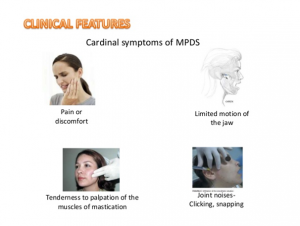Temporomandibular Disorders (TMDs) – Often incorrectly referred to as TMJ, temporomandibular disorders encompass a broad category of conditions involving pain and/or dysfunction of the jaw joints, of the muscles of the jaw (masticatory muscles) or both.
Trigeminal neuropathic pain disorders – The most well known condition is trigeminal neuralgia. It typical symptoms are Sharp, Shooting Pain on face. It require proper diagnosis and treatment. Treatment part divided in three option Medicine, Semi surgical ( injection therapy) or Surgery.
Neurovascular disorders – The most common disorder is migraine. See: FAQ
Complex temporomandibular disorders – Complex conditions include joint replacement failures or other failed multiple TMJ surgeries, co-morbid disease states and neuropathic causes of pain.
Burning mouth syndrome – This condition, which is both painful and frustrating to patients, may be a manifestation of disinhibition, a form of nerve damage. Other causes include a decrease in saliva production, certain medications, fungal infections and some systemic diseases such as diabetes.
Sleep disorders – Sleep problems include symptoms that result from sleep bruxism (grinding the teeth during sleep) and clenching to conditions that result from sleep related breathing disorders such as snoring or sleep apnea.
Orofacialdyskinesias and dystonias – These involve involuntary movements or contractions of muscle because of faulty nerve signals. These can be caused by some medications or nervous system disorders but often have an unknown cause.
Trauma – Trauma, especially from automobile accidents, is still a major cause of temporomandibular disorders and other facial pains.
MPDS-Myofascial Pain Dysfunction Syndrome:Myofascial pain syndrome (MPS) is a fancy way to describe muscle pain. It refers to pain and inflammation in the body’s soft tissues. MPS is a chronic condition that affects the fascia (connective tissue that covers the muscles).
MPDS is a pain disorder, in which unilateral pain is referred from the trigger points in myofacial structures, to the muscles of head and neck. These are localized tender areas within taut bands of skeletal muscles when stimulated by macro- micro traumatic episodes TRIGGER POINTS.
Sensitive areas of tight muscle fibers can form in your muscles after injuries or overuse. These sensitive areas are called trigger points. A trigger point in a muscle can cause strain and pain throughout the muscle. When this pain persists and worsens, it calls as a myofascial pain syndrome.

